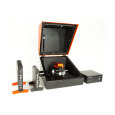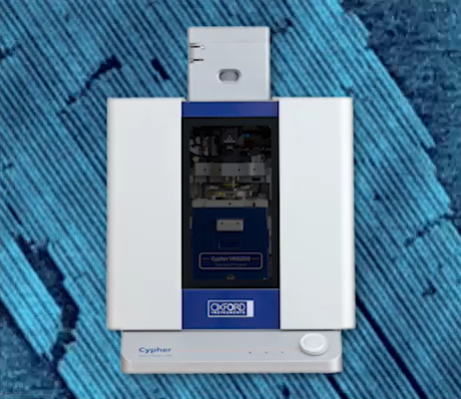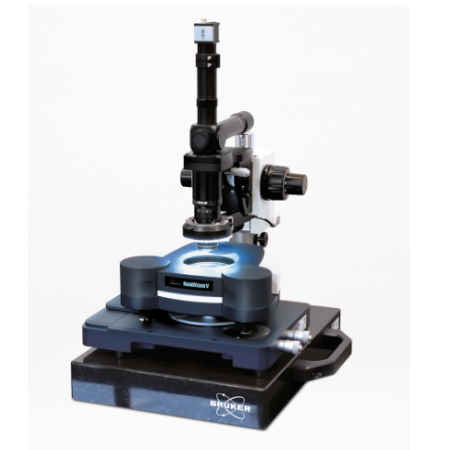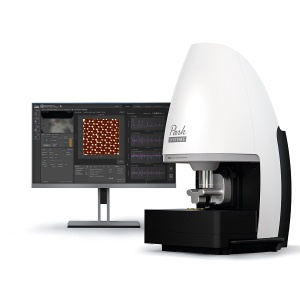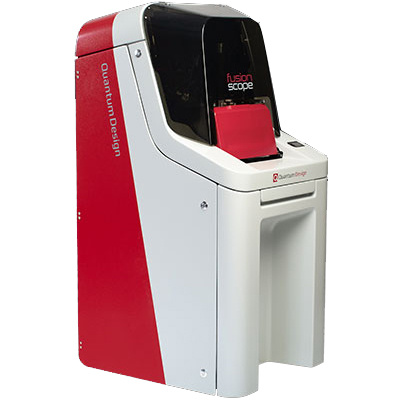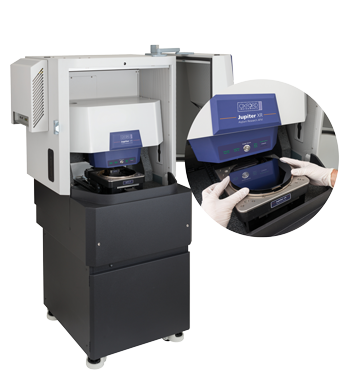扫描热显微镜是一种原子力成像模式,绘制样品表面热传导性的变化。与原子力其他测量材料特性模式(LFM,MFM,EFM)相似,扫描热数据能与形貌像数据同时获得。扫描热模式需要使用特殊的纳米制作的测温探针。
方案详情

AN00462 SCANNING THERMAL MICROSCOPY (STHM) WITH THE EASYScAN 2 FLExAFM Scanning Thermal Microscopy (SThM) with theeasyScan 2 FlexAFM Summary With the development of the easyScan 2 FlexAFM,Nanosurf offers a platform with increased flexibilityfor researchers that require advanced imagingmodes, while still maintaining Nanosurf’s trademarkease of use. Experiments that were not possiblewith the previous easyScan systems are now routinewith the FlexAFM. Being able to accommodate amuch greater selection of specialty cantilevers whileavproviding easy access to system inputs and outputs isone of the many advantages that the FlexAFM offers.This advantage is demonstrated with the integrationof Scanning Thermal Microscopy (SThM) imagingand local thermal analysis capabilities that are offeredby Anasys Instruments. Scanning Thermal Microscopy Scanning Thermal Microscopy is an AFM imagingmode that maps changes in thermal conductivityacross a sample’s surface. Similar to other modes thatmeasure material properties (LFM,MFM, EFM,etc.), SThM data is acquired simultaneously withTopographic data. The SThM mode is made possibleby replacing the standard contact mode cantileverwith a nanofabricated thermal probe with a resistiveelement near the apex of the probe tip. This resistoris incorporated into one leg of a Wheatstone bridge circuit, which allows the system to monitor resistance.This resistance correlates with temperature at theend of the probe, and the Wheatstone bridge maybe configured to either monitor the temperatureof a sample or to qualitatively map the thermalconductivity of the sample. Changes in sampletemperatures are often measured on active devicestructures. For example, it is possible to image hotspots and temperature gradients on devices such asmagnetic recording heads, laser diodes, and electricalcircuits. Thermal conductivity imaging, however, iscommonly applied to composite or blended samples.In this mode, a voltage is applied to the probe and afeedback loop is used to keep the probe at a constanttemperature. As the thermal probe is scanned acrossthe sample surface, more or less energy will be drainedfrom the tip as it scans across different materials. If Figure 1: Scanning Electron Microscopy (SEM) images ofan Anasys thermal probe. (Left) Entire cantilever. (Right)Magnification of the tip. Figure 1: Imaging of a carbon fiber and epoxy sample. (Top)Topography image. Z-range corresponds to 1.4 um. (Bottom)SThM image. Z-range corresponds to 600 mV. The XY-range ofboth images corresponds to 80 pm x90 pm. the region is one of high thermal conductivity, moreenergy will flow away from the tip.When this occurs,the thermal feedback loop will adjust the voltage to theprobe to keep it at a constant temperature. When theprobe moves to an area of lower thermal conductivity,the feedback loop will lowiceder the voltage to the probe,as it will require less energy to keep the probe at aconstant temperature. By adjusting the voltage tokeep the probe temperature constant, a map of thesample's thermal conductivity is generated. Figure 2 displays simultaneously acquired Static ModeTopography and SThM images of a carbon fiber andepoxy sample. The sample has been cross-sectioned Figure 2: Local nano-TA analysis of a poly-ethylene film.Graph showing measurement results that were performed attwo individual sample sites (blue and red curves, respectively).The onset of melting occurs at 115°C. and polished to provide a flat surface. Having asmooth surface will minimize changes in the SThMcontrast that result from topographic effects. In theSThM image here, it is possible to map the thermalconductivity difference of the epoxy regions and thecarbon fibers. As expected, the carbon fibers are seento have a higher thermal conductivity (light blue)than the surrounding epoxy regions (purple). Thesedata also serve to verify the sub-100-nm resolutionthat is expected from the thermal probes. Beyond adding the extended capabilities of SThMimaging, it is also possible to acquire local quantitativethermo-mechanical information with sub-100-nmresolution. This is possible with the nano-TA optionoffered by Anasys Instruments. Once an area ofthermal interest has been identified using standardTopography imaging with the thermal probe, it isthen possible to place the probe at a specific point tomeasure local thermal properties. This information isobtained by linearly ramping the temperature of thenano-TA probe with time while monitoring deflectionof the probe. The thermo-mechanical response allowsthe user to obtain quantitative measurements of phasetransition temperatures such as melting point (Tm)and glass transition temperatures (T ). At the pointof these phase transition temperatures, the samplebeneath the probe will soften, allowing the probe topenetrate into the sample. As seen in Figure 2, thisproduces a plot of probe deflection as a function oftemperature. This breakthrough in spatial resolution ofthermal properties has significant implications in the Figure 3: Nanosurf components required for SThMmeasurement. (Top) The Nanosurf easyScanni2 FlexAFMscan head. (Bottom left) The easyScan 2 Signal Module A.(Bottom right) The FlexAFM Cantilever Holder ST. fields of Polymer Science and Pharmaceuticals whereunderstanding local thermal behavior is crucial. System Requirements The easyScan FlexAFM with Signal Module A andCantilever Holder ST is required to perform SThMimaging and/or local nano-TA sample analysis (seeFigure 3). Anasys Instruments provides hardwareand software that easily integrate with the FlexAFMsystem. Anasys thermal probes are premounted onsupports (Figure 4, top) that are compatible with theFlexAFM Cantilever Holder ST. In the experimentsdescribed here, the Anasys GLA-1 and AN2-200thermal probes were used. The Anasys SThM system(Figure 4, bottom) includes a simple software interfacethat controls the thermal analysis electronics via a USBconnection. This interface is capable of outputting alow-noise, high-resolution voltage to the probe. The Figure 4: Anasyscomponentsrequired forrSThMmeasurement with the FlexAFM scan head. (Top) Anasysthermal probes.(Bottom) Anasys SThM electronics comprisingthe power supply, controller, and CAL box. voltage may be varied over a wide range dependingon the probe type and the desired temperature of theprobe (<0.1℃ resolution). The other components inthe bridge circuit are easily changed if required forcustom experiments, and the system includes an inputconnection to apply AC voltages to the probe. Theresistance of the probe is output on a BNC, whichis then connected to User Input 1 on the easyScan 2Signal Module A. For SThM imaging, the easyScan 2control software is configured to collect the resistancedata on User Input 1, allowing SThM information tobe recorded and displayed as a chart in the imagingwindow of the Nanosurf software. During nano-TAexperiments, the Anasys software allows the User toset Nano-TA2 controller parameters such as heatingrates and temperature range. Typically, AFM feedbackis turned off during the acquisition of nano-TA data. Nanosurf AGGrammetstrasse 14CH-4410 LiestalSwitzerland Phone: +41-61-927 56 46Fax: +41-61-92756 47 Nanosurf is a leading providerofeasy-to-use atomic force andscanning tunneling microscopes.Nanosurf products and services aretrusted by professionals worldwideto help them measure, analyze, andpresent 3D surface information. 2125 Center Avenue, Suite 507Fort Lee, NJ 07024USA Phone: 201-720-2829 Nanosurf - Smart Instruments for Nanoscience & Nanotechnology- Microscopy Made Easy FlexAFM原子力显微镜是Nanosurf公司最新研发的在大气环境和液体环境下都可以进行测试,并且可与倒置光学显微镜和温度样品台联用。可以满足绝大多数研究的需要。瑞士Nanosurf公司,全球知名的专业研发扫描探针显微镜制造商和技术服务供应商,在扫描探针显微镜领域有超过15年的研发经验,一直致力于新型扫描探针显微镜的创新性研发和制造。目前已推出新一代低噪音-快速扫描-超高稳定性的AFM 和大扫描范围Nanite AFM系统。瑞士Nanosurf公司承诺提供最高品质的服务和客户支持,同时还提供纳米技术的OEM 客户定制,外包等业务。技术参数:FLEXAFM原子力显微镜测量模式:接触式原子力显微镜(大气和液态环境),真正非接触式原子力显微镜(大气和液态环境),横向力/摩擦力显微镜(LFM),导电原子力显微镜,磁力显微镜(MFM),开尔文探针(Kelvin Probe),扫描热原子力显微镜(SThM),电容和静电力显微镜(EFM),高级的纳米光刻和纳米操作能力,音叉原子力显微镜,三维扫描成像。扫描范围:100 μm,10 μmZ方向范围:10 μm,3 μmXY方向驱动分辨率:0.152 nmZ方向驱动分辨率:0.046 nm最小Z方向测量噪音水平:0.15nm样品尺寸:直径100mm主要特点:FlexAFM无论是在大气环境下还是在液体环境下都可以进行测试,操作和测试的方便程度是完全一样,没有什么区别。灵活弯曲结构的扫描头设计,可以引用于平的或粗糙的样品表面。XY-扫描通过电磁驱动,XY平面的运动是完全线性的 。Z方向的运动是通过压电陶瓷来驱动,Z方向的运动速度很快。激光光束进入液体时会发生一定偏移,通常实验时需要耐心和复杂的调整。而FlexAFM 使用了专利SureAlign™ 的激光光学系统,无论是在大气下还是在液体中根本不需要做任何调整。所以FlexAFM 的激光信号永远处于最佳状态。两个方向的视窗,非常方便观察和针尖逼近。并且由于特别的设计,使得无论在大气环境还是液体环境得到同样质量的视像。FlexAFM 使用"Liquid Ready" easyScan 2控制器, 可以扩展STM 等技术。
确定
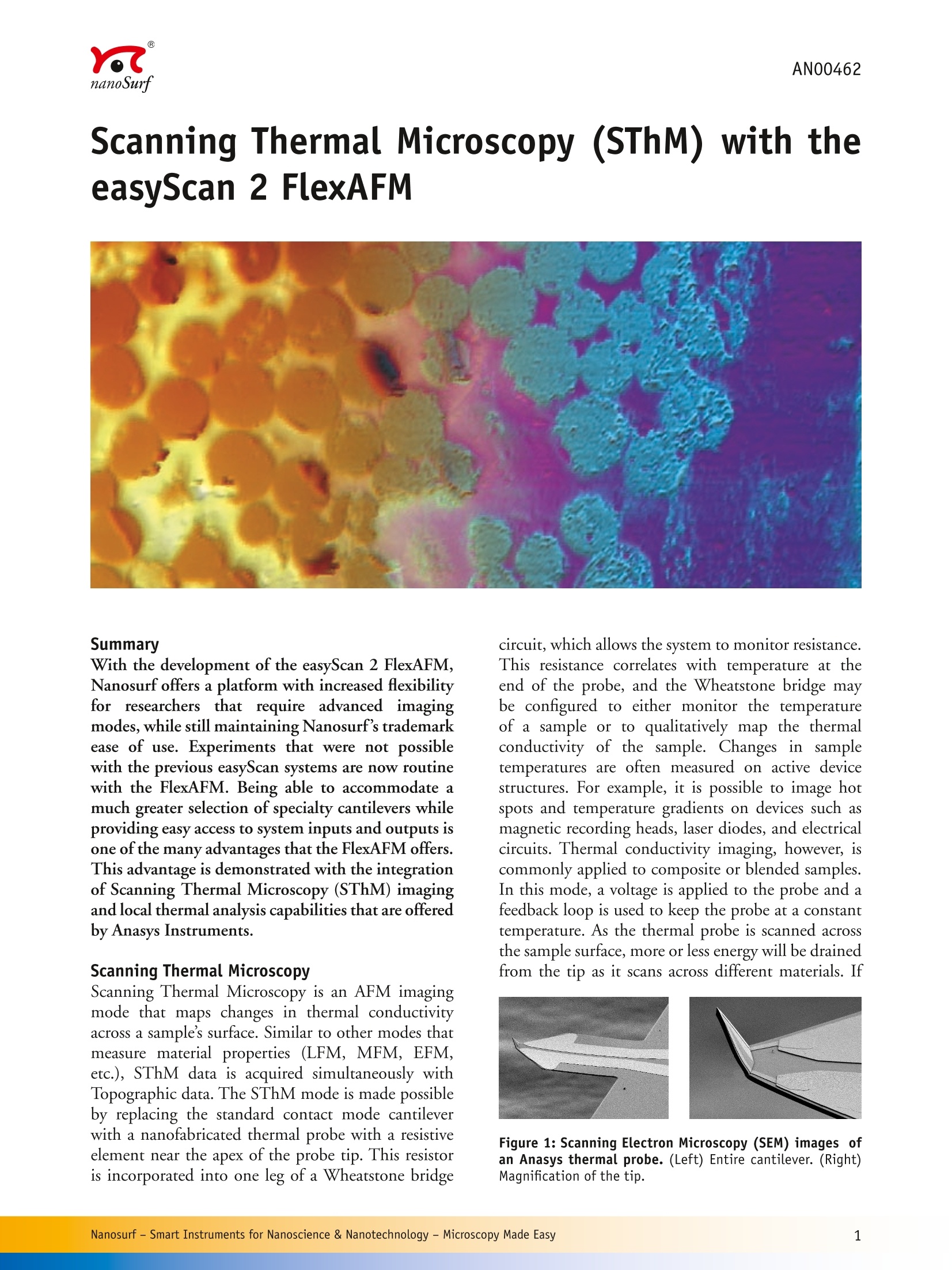

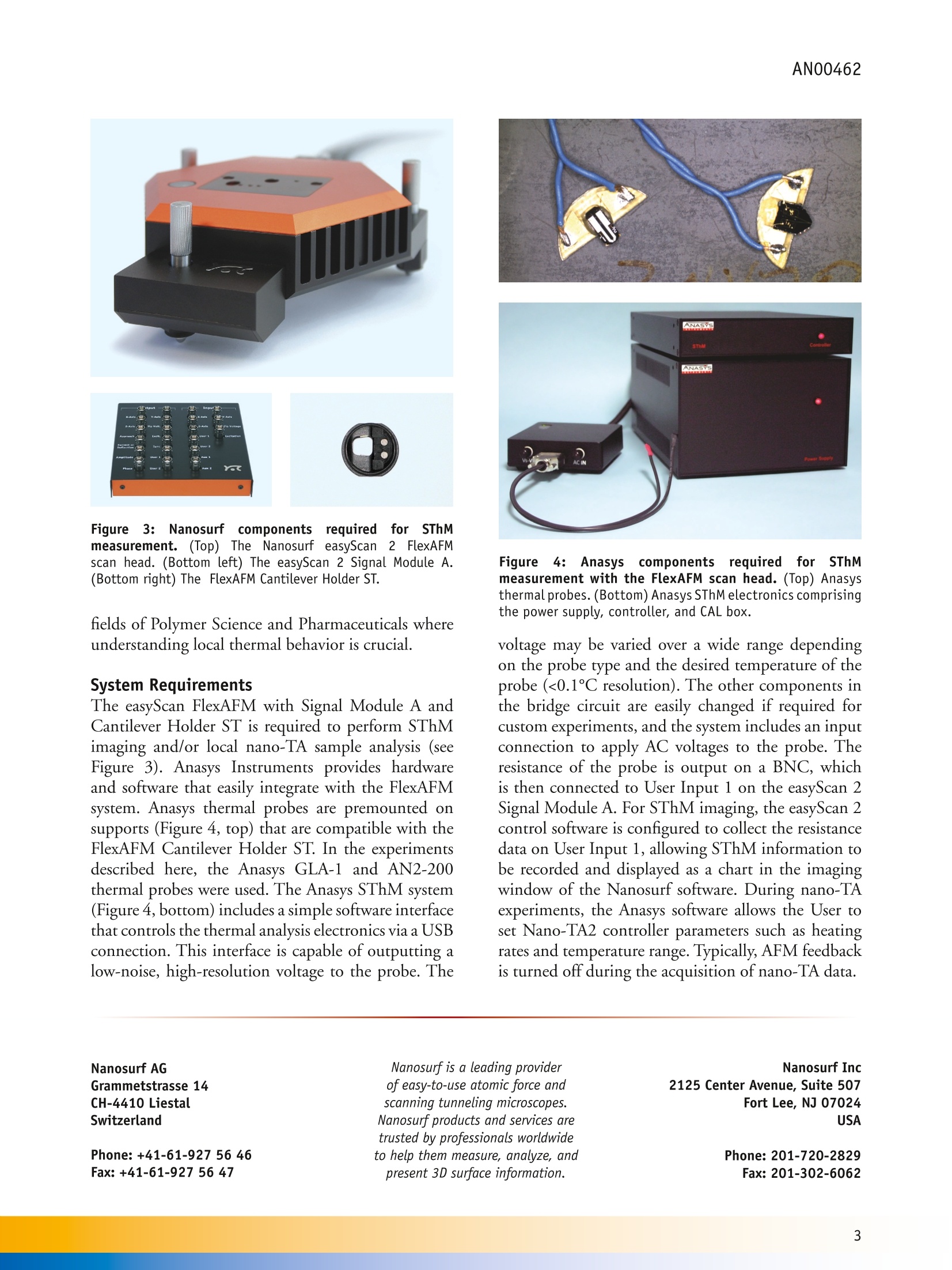
还剩1页未读,是否继续阅读?
北京亿诚恒达科技有限公司为您提供《金属中表面的扫描热数据能与形貌像数据检测方案(扫描探针)》,该方案主要用于纯金属中表面的扫描热数据能与形貌像数据检测,参考标准--,《金属中表面的扫描热数据能与形貌像数据检测方案(扫描探针)》用到的仪器有多功能原子力显微镜
推荐专场
相关方案
更多










